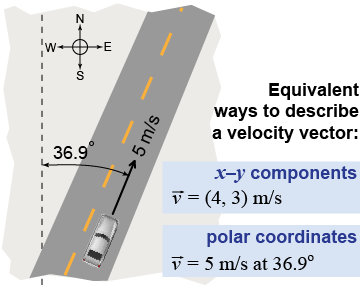|
 How quickly a displacement occurs depends on the velocity vector . The velocity vector is the directional analog of speed. The velocity vector can be represented in polar or Cartesian coordinates, just as for displacement. As an example, suppose a car is moving at 5 m/s on a road that makes an angle of 36.9° east of north. One second after passing through the origin, the car’s position has changed by 5 m along the 36.9° line.
How quickly a displacement occurs depends on the velocity vector . The velocity vector is the directional analog of speed. The velocity vector can be represented in polar or Cartesian coordinates, just as for displacement. As an example, suppose a car is moving at 5 m/s on a road that makes an angle of 36.9° east of north. One second after passing through the origin, the car’s position has changed by 5 m along the 36.9° line. 
|
The displacement of the car has components given by = (+3,+4) m. In Chapter 3 we defined speed as distance divided by time. The vector equivalent is that velocity is displacement divided by time. Time is a scalar; when you divide a vector by a scalar, each component is divided separately—and the result is also a vector. Therefore |
For every 5 m the car moves along its actual path, it changes its position by +3 m in the x-direction and +4 m in the y-direction. The car actually moves along the diagonal, but we can mathematically treat the motion as components along x and y. 
|
All the relationships between among, speed, and time also exist in the same form among displacement, velocity, and time. In three dimensions the single vector equation = /t is actually three separate equations, one for each direction x, y, or z. For two-dimensional problems, there are two equations, one for x and one for y. 
|

|
All of the techniques for solving problems we used for one dimension apply to two and three dimensions as well. The main difference is that there are more variables and more equations. In one dimension, there was just one position variable x, one velocity variable v, one acceleration variable a, and one set of equations. In two dimensions there are two position components (x and y), two velocity components (vx and vy), two acceleration components (ax and ay), and two separate sets of equations for the x- and y-directions. In three dimensions there are three each. That’s a lot of components and equations! Despite the challenge in keeping track of all these components, the problems are conceptually similar to what you have already done. 
|
Name three different ways to describe a velocity vector.
 |
Three different ways to represent a velocity vector are - using Cartesian coordinates, such as vx and vy;
- using polar coordinates, such as vr and θ; and
- using a vector diagram.

|
| |
|

